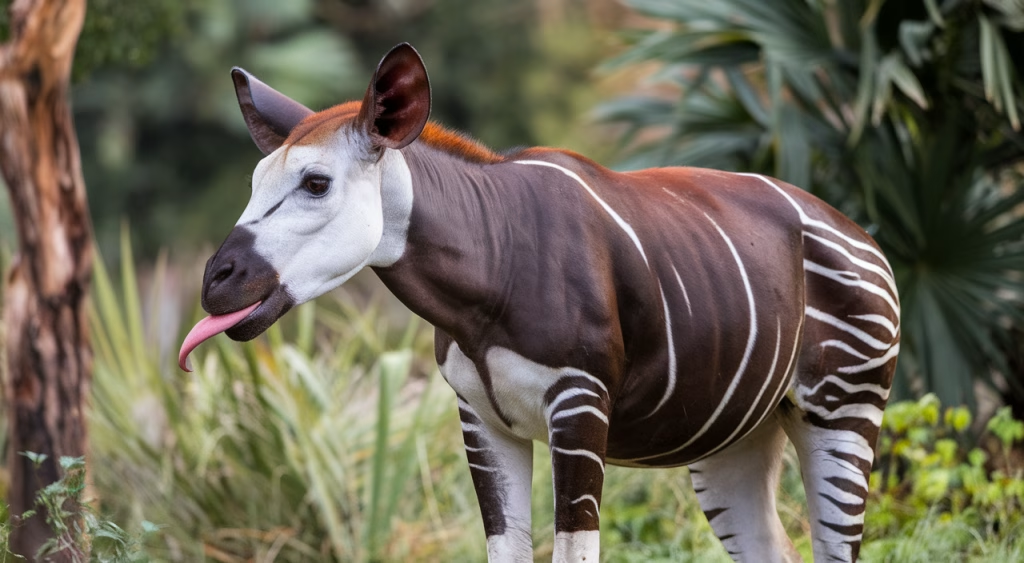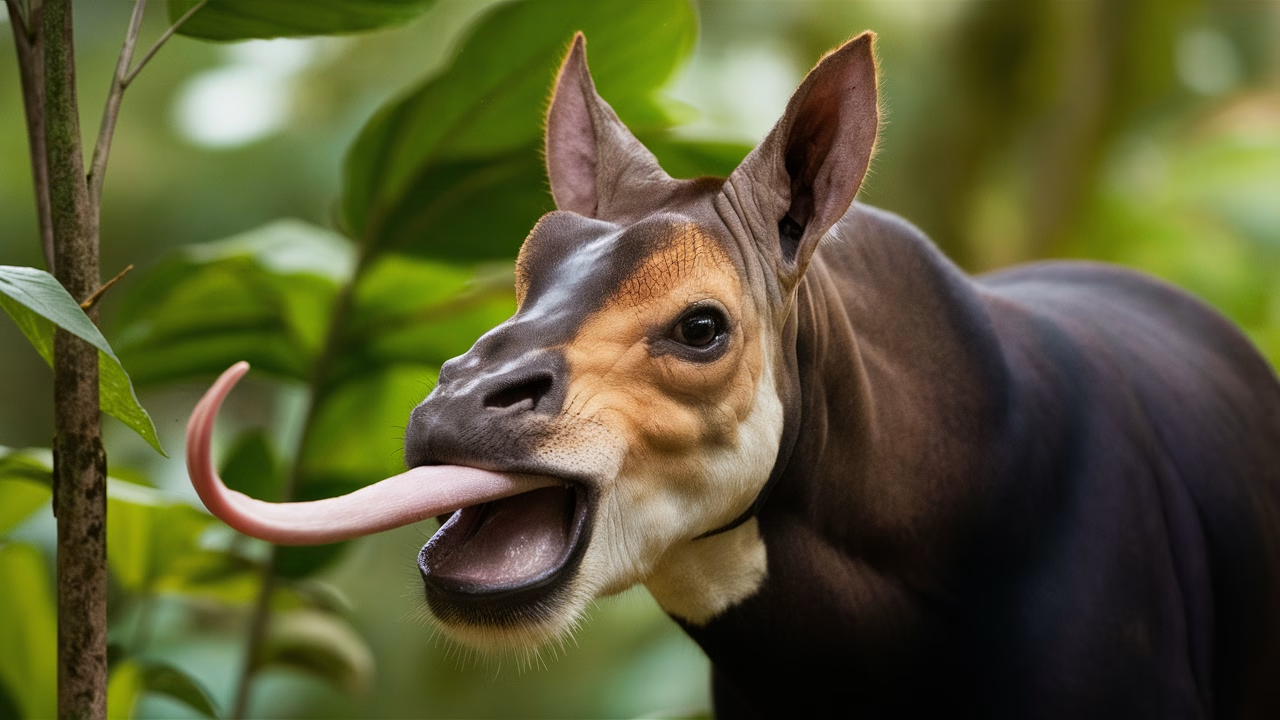How do okapis clean their eyes and ears with their tongue?
Okapis use their elongated, muscular tongues—measuring up to 18 inches—to clean hard-to-reach areas of their body, including their eyes and ears. This remarkable okapi tongue hygiene behavior is both a survival adaptation and essential for overall health in their dense rainforest habitat.
TL;DR: Okapi Tongue Hygiene Explained
- Prehensile Tongue Power: With tongues stretching 14–18 inches, okapis can groom areas most animals can’t reach, including their eyes and ears.
- Self-Grooming Specialist: Their okapi grooming habits are essential for staying parasite-free in the Ituri rainforest.
- Eye & Ear Cleaning: Unlike most mammals, okapis use their tongue to delicately remove debris from sensitive facial features.
- Evolutionary Marvel: This tongue behavior illustrates an extraordinary animal tongue adaptation rooted in survival.
- Conservation Status: Okapis are endangered, and understanding their unique behaviors helps promote preservation efforts.
Introduction: The Fascinating World of the Okapi
Ever imagined an animal so limber and dexterous that it could lick its own eyeballs? Welcome to the extraordinary life of the okapi—often called the “forest giraffe.” Hidden deep within the Ituri Forest of the Democratic Republic of the Congo, the okapi (Okapia johnstoni) is a marvel you seldom see on wildlife documentaries, yet it’s brimming with biological curiosities. Among its most eye-popping traits is its awe-inspiring okapi tongue hygiene practices, a behavior few creatures can match in both utility and eccentricity.
For wildlife enthusiasts, zoology students, and animal behaviorists, diving into okapi grooming habits opens a window to broader questions in evolutionary biology and ecological survival. Understanding these fascinating animal behaviors helps us appreciate the incredible adaptations that allow species to thrive in challenging environments.
Anatomy of an Okapi Tongue: Unraveling Nature’s Design
The okapi’s tongue is truly a marvel of evolutionary engineering. Stretching up to 45 centimeters (about 18 inches), it’s prehensile, muscular, and incredibly agile. This dexterity enables the okapi to access food, groom its coat, and maintain okapi tongue hygiene with precision. The tongue’s skin contains a high concentration of melanin—resulting in a dark, bluish-purple hue that helps it resist sun damage and bacterial growth.
The length and flexibility of this remarkable tongue allow it not only to reach branches when feeding on tree leaves—as its taller cousin the giraffe does—but also to maintain meticulous personal hygiene through sophisticated grooming behaviors.
| Feature | Function |
|---|---|
| Length (18 inches) | Reaches ears and eyes easily |
| Color (dark blue-purple) | Reduces UV exposure; antibacterial property |
| Prehensility | Grasps and moves with great precision |
| Muscular Control | Allows delicate eye and ear cleaning |
Okapi Grooming Habits: A Closer Look at Their Hygiene Rituals
Okapis are solitary by nature, so self-care is vital for their survival. In the thick understory of their Central African habitats, parasites abound, and dirt collects quickly on fur and skin. Yet, unlike most animals that use their limbs or rely on others for grooming, an okapi handles the task solo—with remarkable efficiency through their okapi grooming habits.
The tongue plays a starring role in these hygiene routines. Here’s what makes their grooming behavior so unique:
- Facial cleaning: Particularly fascinating is their ability to wipe crust, debris, and dust away from their eyes and ears with gentle, targeted movements of their tongue.
- Body licking: Okapis are highly flexible, bending their necks and looping their tongue to clean flanks, ribs, and even posterior areas like the hips.
- Ear hygiene: By curling their tongues inward, okapis remove parasites or excess wax from their outer ears through precise okapi tongue hygiene techniques.
This makes okapis exceptional examples of unusual animal grooming behavior. Not only is this smart for personal upkeep, but it minimizes scent trails—helping them avoid predators like leopards.
Behavioral Insights: How Okapi Utilize Their Long Tongues
The use of the tongue for grooming isn’t just a quirky anecdote—it’s rooted in biological survival. Let’s explore why this animal tongue adaptation evolved and what it means in a broader wildlife hygiene context.
1. Why eye-cleaning? In a dense rainforest teeming with pollen, spores, dust, and insects, eye exposure is constant. A clean, moist ocular surface supports healthy vision and deters inflammation or parasites. Okapi tongue hygiene, while shocking to us, is delicately executed by okapis with stunning regularity.
2. Significance of ear-cleaning: Elevated ear hygiene ensures better hearing. Okapis possess large, cupped ears that swivel independently, amplifying even faint rustles of approaching dangers. In the wild, clean ears maintained through okapi grooming habits are a functional asset—not just a cosmetic perk.
3. Defensive grooming: Unlike herd animals that rely on collective vigilance, solitary okapis must be clean, quiet, and scentless to elude notice. Their grooming behavior via the tongue minimizes the need for scratching or external grooming that might leave scents or make noise.
Conservation Efforts: Protecting the Unique Species
The okapi may be crowned as the ambassador of forest stealth, but even this legendary animal isn’t immune to modern dangers. Classified as Endangered by the IUCN, okapis face severe threats from habitat destruction, mining, logging, and poaching.
Organizations operating in the Congo Basin, supported by international wildlife groups, are spearheading okapi conservation efforts. Most notably, the Okapi Wildlife Reserve protects over 13,700 square kilometers of primary rainforest—a critical step in keeping okapis (and their ecosystems) alive.
Your awareness and advocacy help. When you learn about their behavior—like okapi tongue hygiene and okapi grooming habits—you become part of a broader push to preserve one of Earth’s most enigmatic creatures.
Conclusion: Appreciating the Beauty of Okapi’s Unusual Adaptations
In the wild, survival is often a matter of inches—sometimes quite literally. For the okapi, those precious inches of tongue make the difference between healthy vision, clear hearing, and vulnerability. It’s not just a quirky adaptation but a masterclass in how evolution addresses specific needs with creative, biological design.
As wildlife lovers and students of nature, we get a unique opportunity to appreciate not just exotic traits, but purposeful adaptations. From fascinating animal tongue adaptations to wildlife eye and ear cleaning habits, the okapi teaches us that even the most subtle behaviors can carry monumental meaning. Understanding okapi grooming habits and supporting okapi conservation efforts helps ensure these remarkable creatures continue to demonstrate their incredible okapi tongue hygiene techniques for generations to come.
Frequently Asked Questions
What is special about okapi tongues?
The okapi tongue is incredibly long (up to 18 inches), prehensile, dark-colored, and flexible—allowing it to reach and clean its own eyes and ears.
Do okapis use their tongues to clean their ears?
Yes, okapis can reach their ears with their tongues and routinely clean them as part of their self-grooming behavior.
Why do okapis lick their own eyes?
Okapis lick their own eyes to remove dust, debris, or parasites. This helps protect their sensitive vision and maintain optimal eye health in rainforest conditions.
Where do okapis live?
They inhabit dense tropical rainforests, primarily in the Democratic Republic of Congo’s Ituri Forest.
Are okapis endangered?
Yes. Okapis are classified as Endangered due to habitat loss, illegal poaching, and human conflict in their native region.
What are some other animals with unique grooming methods?
Other examples include elephants using their trunks, cats using barbed tongues, and giraffes—also using their tongues similarly to okapis.
How can we help conserve okapis?
Support conservation funds, raise awareness, and opt for sustainably sourced products to help combat deforestation in okapi habitats.





